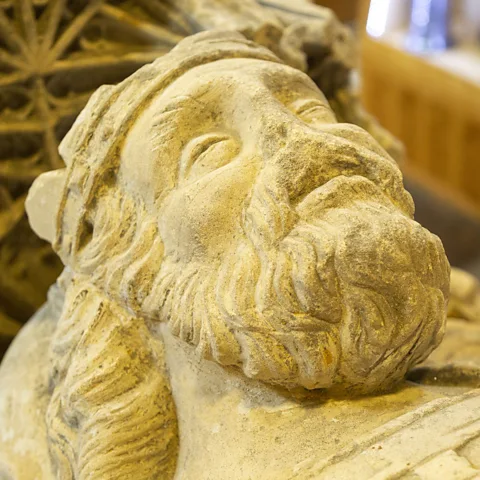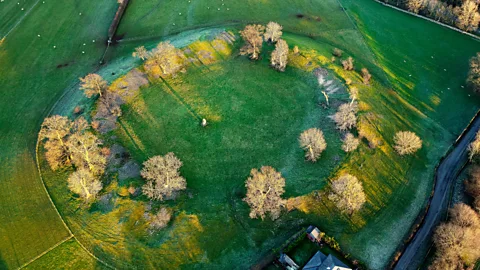How England misplaced its first king
 The Parker Library, Corpus Christi College, Cambridge
The Parker Library, Corpus Christi College, CambridgeIn his lifetime, the first king of England was renowned throughout Europe. But over the centuries, he has been sidelined by history.
For a king who achieved so much, Æthelstan is a remarkably mysterious monarch. It is 1,100 years since he was crowned the first king of England, yet he has remained surprisingly absent from the history books.
While Æthelstan himself may have been largely forgotten, his legacy still looms large. (The "Æ", by the way, is pronounced like the "a" in cat). Not only did he unite several disparate kingdoms to create England, but he built a deep and complex relationship with mainland Europe. At home, he ruled over a diverse kingdom of people with different cultures and identities. He set trends too as the first English monarch to wear a crown – a tradition that continues today.
After he died, however, Æthelstan was soon overshadowed by the legacy of his grandfather, Alfred the Great. In Elizabethan times, he was passed over in the search for English origin stories. In the Victorian era, he was little more than a side note as historians turned to the past to reinforce ideas of empire.
It is time this monarch was better remembered, argues David Woodman, professor of history at Robinson College, University of Cambridge in the UK, and author of a new biography of Æthelstan. This month – September 2025 – marks the 1,100-year anniversary of his coronation, and a closer look at his reign reveals some insightful lessons for those hoping to understand what it means to be English.
If nothing else, Æthelstan's story overturns the centuries-long notion that England was originally a homogeneous culture, says Woodman. It's a misconception that still resurfaces today, but the truth was very different.
Who was Æthelstan?
Æthelstan was the grandson of perhaps the most famous king of the early medieval period, Alfred the Great. Alfred was known for his battles with the Vikings, and for decisively defeating the Danes in the 9th Century. Through his tussles with the Danes, he was able to establish influence in parts of the former rival kingdom of Mercia, which stretched from the midlands to the east of England, expanding his kingdom up from Wessex, in the south of England.
"It's Alfred's son, Edward, Æthelstan's father, who conquered East Anglia from the Danes," says Sarah Foot, dean of Christ Church College and former regius professor of ecclesiastical history at the University of Oxford. Edward the Elder, as he was known, used a new form of warfare that created fortress towns to take and hold large swathes of enemy territory. "And Edward died as king all the way up to the River Humber [in East Yorkshire]." By then he had earned the title he inherited from Alfred, king of the Anglo-Saxons. Edward's deeds set the stage for his son.
Æthelstan, born around the year 894AD, was next in this line of kings and continued the family tradition of expanding the kingdom.
 The Parker Library, Corpus Christi College, Cambridge
The Parker Library, Corpus Christi College, CambridgeHow did Æthelstan create England?
In 924AD Æthelstan became king when his father Edward died. There is some suggestion that Æthelstan's half-brother, Ælfweard, was initially king of Wessex when Edward died, while Æthelstan was made king of Mercia. "Whatever the case, Ælfweard died within a month – we don't know in what circumstances – and Æthelstan then naturally became sole king of the kingdom of the Anglo-Saxons," says Woodman.
He was officially crowned in September 925AD. The following year, in 926AD, he married off his sister to the Viking king of Northumbria, which lay to the north of his kingdom's border. A year later, the Viking ruler died, and Æthelstan took over Northumbria.
"It's easy to assume foul play, but we don't know," says Clare Downham, professor of medieval history at the University of Liverpool in the UK. "That is a key moment in the creation of the English kingdom." In consolidating the previously separate kingdoms of Wessex, Mercia and Northumbria, Æthelstan became the first king of all England.
"He knew what he was doing," says Foot. "He knew that he'd created a new kind of realm and he'd brought a unity to the British Isles that they hadn't known since Roman times."
This unity was key to defending his newly formed kingdom. "He's aware of the importance of bringing people together in the face of Viking attacks," says Woodman. "But there's also an element of personal ambition here. This is a way to extend his authority."
The new English kingdom held throughout the rest of his lifetime. It was reinforced at the Battle of Brunanburh in 937AD, when he defeated an alliance of Vikings, Scots and Strathclyde Welsh, who were attempting to challenge his rule of England. It's not known exactly where this battle took place, but it may have been in north-west England.
What was Æthelstan's England like?
Amid all the battles and conquest, however, Æthelstan brought a cosmopolitan flair to his new kingdom. Today there is a tendency – particularly among the far right – to depict early England as being cut off from the rest of Europe, and homogeneous in its cultural makeup. In truth, the newly formed kingdom of England was an outward-looking society.
"There's been a big debate about the very use of the word Anglo-Saxon, so much so that people in our field of scholarship are not using the word anymore, and are going towards Early Medieval instead because of the connotations that Anglo-Saxon now has with the far right," says Woodman. "When [the term Anglo-Saxon] is invoked by the far right, they're thinking of it as very one-dimensional – people from one background in England in the 10th Century."
In fact, that's a big misconception of what the period was like. "It was actually a very diverse place in early 10th Century. I always think about Æthelstan's Royal Assemblies, and there were people there from lots of different kingdoms within England, Britain more widely, from Europe. They were speaking a multiplicity of languages, Old Welsh, Old Norse, Old English, Latin. I just feel [the term Anglo-Saxon] is used without thinking, and without factual detail about the early 10th Century."
Downham agrees. "There was a lot of cultural variety in the area we call England today. There wasn't this English monolith that started in 500AD."
Æthelstan also sought deep ties with other nations in Europe in a way that monarchs before him hadn't, developing a coherent foreign policy. "He's very connected with contemporary Europe," says Woodman. "He's marrying off some of his half-sisters into contemporary ruling houses of Europe and he's encouraging scholars from Europe to visit England."
 Getty Images
Getty ImagesWhat happened when he died?
Despite his leadership, the kingdom Æthelstan forged did not survive his death intact. When he died in 939AD, it quickly fragmented and a Northumbrian kingdom formed once again.
"For me, that shows the fragility of what he'd made, but also the precociousness of his achievement – that so much had rested on him as an individual," says Woodman. "It really shows what he was driving forward as the king."
But the idea of the larger kingdom created by Æthelstan remained. "From 954AD onwards it's back to being a unitary realm and it's not split permanently again," says Foot.
Why was Æthelstan forgotten?
"As the first king of all England, he should be right up there in the popular consciousness," says Foot. "But he's eclipsed by Alfred."
There are a wealth of sources for Alfred's life, including a biography written during his lifetime by the Welsh monk Asser. These sources bring Alfred to life "so that you can talk about a real person", says Foot, who wrote the first academic biography of Æthelstan.
For Æthelstan, that just wasn't possible. "That's one of the reasons that Æthelstan is so little-known today," says Woodman. "He just didn't have a major contemporary biographer who was writing an account of his life in the same way that his grandfather did."
The reason why is unknown. "Maybe he was partly busking on the reputation of his grandfather," says Downham. It's also possible that there was one written, but it hasn't survived. "So many texts have been lost. So many books destroyed through fire or flood or deliberate destruction. So it's hard to know what was once there."
After his death, a biography was written in the 10th Century, which we know because a later text refers to it, says Foot. But the original text hasn't survived.
"We do have good record of diplomas, writs and agreements from his reign," says Downham. This was largely because the practice of government became far more efficient and established under Æthelstan. "But they're not as much fun as a rip-roaring history that gives you a biography of the individual."
 Alamy
AlamyDespite having no biographer of his own in his lifetime, historians today are rising to the challenge of piecing together his life and legacy. As well as being a military power, ruthless in his quest to expand his territory, and ambitious in his relations with other countries, he also clearly felt style was important.
"Æthelstan was a king who cared hugely about his image," says Foot. "He minded what he looked like, he minded what was said about him."
In many ways, Æthelstan was a king ahead of his time, says Woodman. He was intellectually curious, established central oversight for how his kingdom was governed and began to define a sense of what royal power would come to mean.
Some elements of Æthelstan's talent for the theatrical still survive today. Many of the prayers and rituals in King Charles III's coronation in 2023, including the anointing and crowning, were the same as in Æthelstan's 1,100 years ago, says Foot. "There is an enormous continuity," she says.
Perhaps the most important image that has survived is the earliest surviving manuscript portrait of an English monarch. It shows Æthelstan wearing his crown and holding a book, bowing before St Cuthbert. "It's one of the most important images in English history," says Woodman.
--
If you liked this story, sign up for The Essential List newsletter – a handpicked selection of features, videos and can't-miss news, delivered to your inbox twice a week.
For more science, technology, environment and health stories from the BBC, follow us on Facebook and Instagram.
